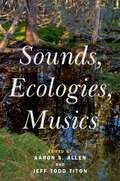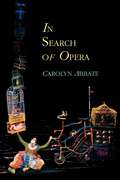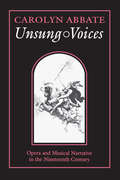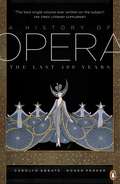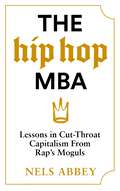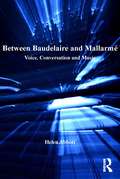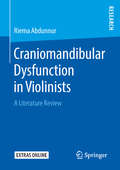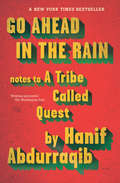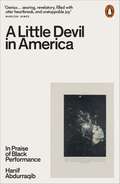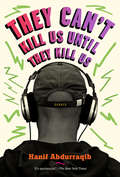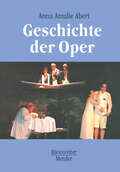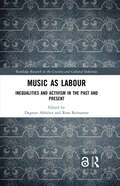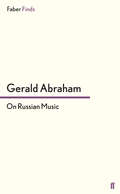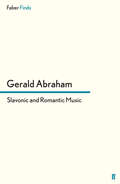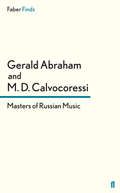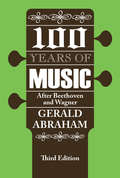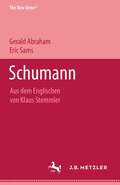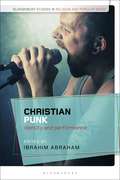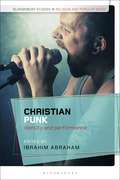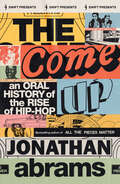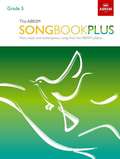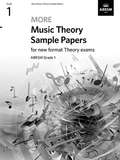- Table View
- List View
Sounds, Ecologies, Musics
by Aaron S. Allen and Jeff Todd TitonSounds, Ecologies, Musics poses exciting challenges and provides fresh opportunities for scholars, scientists, environmental activists, musicians, and listeners to consider music and sound from ecological standpoints. Authors in Part I examine the natural and built environment and how music and sound are woven into it, how the environment enables music and sound, and how the natural and cultural production of music and sound in turn impact the environment. In Part II, contributors consider music and sound in relation to ecological knowledges that appear to conflict with, yet may be viewed as complementary to, Western science: traditional and Indigenous ecological and environmental knowledges. Part III features multidisciplinary and interdisciplinary approaches by scholars, scientists, and practitioners who probe the ecological imaginary regarding the complex ideas and contested keywords that characterize ecomusicology: sound, music, culture, society, environment, and nature. A common theme across the book is the idea of diverse ecologies. Once confined to the natural sciences, the word "ecology" is common today in the social sciences, humanities, and arts - yet its diverse uses have become imprecise and confusing. Engaging the conflicting and complementary meanings of "ecology" requires embracing a both/and approach. Diverse ecologies are illustrated in the methodological, terminological, and topical variety of the chapters as well as the contributors' choice of sources and their disciplinary backgrounds. In times of mounting human and planetary crises, Sounds, Ecologies, Musics challenges disciplinarity and broadens the interdisciplinary field of ecomusicologies. These theoretical and practical studies expand sonic, scholarly, and political activism from the diversity-equity-inclusion agenda of social justice to embrace the more diverse and inclusive agenda of ecocentric ecojustice.
In Search of Opera
by Carolyn AbbateIn her new book, Carolyn Abbate considers the nature of operatic performance and the acoustic images of performance present in operas from Monteverdi to Ravel. Paying tribute to music's realization by musicians and singers, she argues that operatic works are indelibly bound to the contingency of live singing, playing, and staging. She seeks a middle ground between operas as abstractions and performance as the phenomenon that brings opera into being. Weaving between opera's "facts of life" and a series of works including The Magic Flute, Parsifal, and Pelléas, Abbate explores a spectrum of attitudes towards musical performance, which range from euphoric visions of singers as creators to uncanny images of musicians as lifeless objects that have been resuscitated by scripts. In doing so, she touches upon several critical issues: the Wagner problem; coloratura, virtuosity, and their critics; the implications of disembodied voice in opera and film; mechanical music; the mortality of musical sound; and opera's predilection for scenes positing mysterious unheard music. An intersection between transcendence and intense physical grounding, she asserts, is a quintessential element of the genre, one source of the rapture that operas and their singers can engender in listeners. In Search of Opera mediates between an experience of opera that can be passionate and intuitive, and an intellectual engagement with opera as a complicated aesthetic phenomenon. Marrying philosophical speculation to historical detail, Abbate contemplates a central dilemma: the ineffability of music and the diverse means by which a fugitive art is best expressed in words. All serious devotees of opera will want to read this imaginative book by s music-critical virtuoso.
Unsung Voices: Opera and Musical Narrative in the Nineteenth Century
by Carolyn AbbateWho "speaks" to us in The Sorcerer's Apprentice, in Wagner's operas, in a Mahler symphony? In asking this question, Carolyn Abbate opens nineteenth-century operas and instrumental works to new interpretations as she explores the voices projected by music. The nineteenth-century metaphor of music that "sings" is thus reanimated in a new context, and Abbate proposes interpretive strategies that "de-center" music criticism, that seek the polyphony and dialogism of music, and that celebrate musical gestures often marginalized by conventional music analysis.
A History of Opera: The Last Four Hundred Years
by Carolyn Abbate Roger ParkerOpera is in many ways the most extraordinary artistic medium of the last four hundred years. Prohibitively expensive and patently unrealistic, it can nevertheless paint the human passions with astonishing power and drama. This book, the first new, full-length, single-volume history of opera for more than a generation provokes in-depth discussions of many works by the greatest opera composers, from Monteverdi, Handel and Mozart, to Verdi and Wagner, to Strauss, Puccini, Berg, and Britten. There are lively discussions of opera's social, political and literary background, its economic cicumstances and the almost continual polemics that have accompanied its development through the centuries. Central to the book is an exploration of the tensions that have always sustained and enlivened opera. Abbate and Parker examine the problems that opera has faced in the last half century, when new works - which were once opera's life-blood - have shrunk to a tiny minority, have largely failed to find a permanent place in the repertoire. Yet the book's final message is one of celebration. Even if the majority of opera's most popular and enduring works were written in what is now a remote European past, in circumstances very different from our own, and the viability of contemporary opera is ever more in question, opera as an art form remains extraordinarily buoyant and challenging. It continues to transform people physically, emotionally, and intellectually, and to articulate human experience in ways no other art form can match.
The Hip-Hop MBA: Lessons in Cut-Throat Capitalism from Rap’s Moguls
by Nels AbbeyWhat does the founding of the Sugarhill Gang teach us about business development? What can we learn about management and leadership from Jay-Z’s decades-long dominance? What does Ice Cube’s refusal to accept $75,000 to remain a member of NWA tell us about risk management? What can we learn about market dominance from the Death Row and Bad Boy Records beef? What does the rise and fall of MC Hammer (and the near fall of Rihanna) reveal about the psychology of money management? Does Lil Nas X have anything to teach us about corporate diversity? In The Hip Hop MBA, banker–turned–writer Nels Abbey offers an alternative and entertaining look at business and economics through the rise and triumph of Hip Hop. This is the story of how rap industrialists – like Jay-Z, Suge Knight, Sylvia Robinson, Puff Daddy, 50 Cent and Bryan ‘Birdman’ Williams – took chronic economic pain and turned it into champagne. With a business acumen often acquired in the streets, these moguls created and sustained a multi-billion-dollar industry – leaving Greek mythology-worthy stories of success and failure, betrayal and revenge in their wakes. The world of business hasn’t taken Hip Hop moguls or their methods anywhere near seriously enough – until now. The Hip Hop MBA is taking you back to school.
Between Baudelaire and Mallarmé: Voice, Conversation and Music
by Helen AbbottAs the status of poetry became less and less certain over the course of the nineteenth century, poets such as Baudelaire and Mallarmé began to explore ways to ensure that poetry would not be overtaken by music in the hierarchy of the arts. Helen Abbott examines the verse and prose poetry of these two important poets, together with their critical writings, to address how their attitudes towards the performance practice of poetry influenced the future of both poetry and music. Central to her analysis is the issue of 'voice', a term that remains elusive in spite of its broad application. Acknowledging that voice can be physical, textual and symbolic, Abbott explores the meaning of voice in terms of four categories: (1) rhetoric, specifically the rules governing the deployment of voice in poetry; (2) the human body and its effect on how voice is used in poetry; (3) exchange, that is, the way voices either interact or fail to interact; and (4) music, specifically the question of whether poetry should be sung. Abbott shows how Baudelaire and Mallarmé exploit the complexity and instability of the notion of voice to propose a new aesthetic that situates poetry between conversation and music. Voice thus becomes an important process of interaction and exchange rather than something stable or static; the implications of this for Baudelaire and Mallarmé are profoundly significant, since it maps out the possible future of poetry.
Between Baudelaire and Mallarmé: Voice, Conversation and Music
by Helen AbbottAs the status of poetry became less and less certain over the course of the nineteenth century, poets such as Baudelaire and Mallarmé began to explore ways to ensure that poetry would not be overtaken by music in the hierarchy of the arts. Helen Abbott examines the verse and prose poetry of these two important poets, together with their critical writings, to address how their attitudes towards the performance practice of poetry influenced the future of both poetry and music. Central to her analysis is the issue of 'voice', a term that remains elusive in spite of its broad application. Acknowledging that voice can be physical, textual and symbolic, Abbott explores the meaning of voice in terms of four categories: (1) rhetoric, specifically the rules governing the deployment of voice in poetry; (2) the human body and its effect on how voice is used in poetry; (3) exchange, that is, the way voices either interact or fail to interact; and (4) music, specifically the question of whether poetry should be sung. Abbott shows how Baudelaire and Mallarmé exploit the complexity and instability of the notion of voice to propose a new aesthetic that situates poetry between conversation and music. Voice thus becomes an important process of interaction and exchange rather than something stable or static; the implications of this for Baudelaire and Mallarmé are profoundly significant, since it maps out the possible future of poetry.
Craniomandibular Dysfunction in Violinists: A Literature Review
by Riema AbdunnurRiema Abdunnur gives insight into publications focusing on performing violinists, particularly on those suffering from CMD, subsequently providing a better understanding to the unique work conditions of violinists, and enhancing diagnosis and therapeutic results by practitioner dentists. Moreover, the analysis of the included papers aims to reveal what exactly was studied in violinists regarding to CMD, and how far manual medicine was included there. The conclusion of the author is, playing violin could be classified as a potential factor associated with CMD in violinists. More researches that take the interdisciplinary collaboration between dental and manual medicine into special account are recommended.About the Author Riema Abdunnur did her research studies at Medical University of Innsbruck, Austria.
Go Ahead in the Rain: Notes to A Tribe Called Quest
by Hanif AbdurraqibA stunning homage to A Tribe Called Quest and a musical era that shaped American culture, from critically acclaimed Hanif Abdurraqib.How does one pay homage to A Tribe Called Quest? Hanif Abdurraqib digs into the group’s history and draws from his own experience to reflect on how the band’s distinctive sound resonated among fans like himself.Abdurraqib traces the Tribe’s creative career: from their early days as part of the Afrocentric rap collective known as the Native Tongues, through their first three classic albums, to their eventual breakup and long hiatus. Their work is placed in the context of the broader rap landscape of the 1990s, one upended by sampling laws that forced a reinvention in production methods, the East Coast–West Coast rivalry that threatened to destroy the genre, and some record labels’ shift from focusing on groups to individual MCs.Throughout the narrative Abdurraqib connects both the music and cultural history to their street-level impact and seeks the deeper truths of A Tribe Called Quest; truths that—like the low end, the bass—are not simply heard in the head, but felt in the chest.
A Little Devil in America: In Praise of Black Performance
by Hanif AbdurraqibAn electrifying celebration of Black performances, cultures and communities in the United States, from the New York Times bestselling poet and critic Hanif Abdurraqib'Gorgeous' - Brit Bennett'Pure genius' - Jacqueline Woodson'One of the most dynamic books I have ever read' - Clint SmithAt the March on Washington, Josephine Baker reflected on her life and her legacy. She had spent decades as one of the most successful entertainers in the world, but, she told the crowd, "I was a devil in other countries, and I was a little devil in America, too". Inspired by these words, Hanif Abdurraqib has written a stirring meditation on Black performance in the modern age, in which culture, history and his own lived experience collide.With sharp insight, humour and heart, Abdurraqib explores a sequence of iconic and intimate performances that take him from mid-century Paris to the moon -- and back down again, to a cramped living room in Columbus, Ohio. Each one, he shows, has layers of resonance across Black and white cultures, the politics of American empire, and his own personal history of love and grief -- whether it's the twenty-seven seconds of 'Gimme Shelter' in which Merry Clayton sings, or the magnificent hours of Aretha Franklin's homegoing; Beyoncé's Super Bowl show or a schoolyard fistfight; Dave Chapelle's skits or a game of spades among friends.
They Can't Kill Us Until They Kill Us: Essays
by Hanif AbdurraqibA stunning collection of essays using music as a vantage point through which to examine and interrogate the world we live in, culturally and politically.In an age of confusion, fear, and loss, Hanif Abdurraqib’s is a voice that matters. Whether he’s attending a Bruce Springsteen concert the day after visiting Michael Brown’s grave, or discussing public displays of affection at a Carly Rae Jepsen show, he writes with a poignancy and magnetism that resonates profoundly.In the wake of the nightclub attacks in Paris, he recalls how he sought refuge as a teenager in music, at shows, and wonders whether the next generation of young Muslims will not be afforded that opportunity now. While discussing the everyday threat to the lives of black Americans, Abdurraqib recounts the first time he was ordered to the ground by police officers: for attempting to enter his own car.In essays that have been published by the New York Times, MTV, and Pitchfork, among others—along with original, previously unreleased essays—Abdurraqib uses music and culture as a lens through which to view our world, so that we might better understand ourselves, and in so doing proves himself a bellwether for our times.
Music as Labour: Inequalities and Activism in the Past and Present (Routledge Research in the Creative and Cultural Industries)
by Dagmar AbfalterThis book brings together research at the intersection of music, cultural industries, management, antiracist politics and gender studies to analyse music as labour, in particular highlighting social inequalities and activism. Providing insights into labour processes and practices, the authors investigate the changing role of manifold actors, institutions and technologies and the corresponding shifts in the valuation and evaluation of music achievements that have shaped the relationship between music, labour, the economy and politics. With research into a variety of geographic regions, chapters shed light on the various ways by which musicians’ work is performed, constructed and managed at different times and show that musicians’ working practices have been marked by precarity, insecurity and short-term contracts long before capitalism invited everybody to ‘be creative’. In doing so, they specifically examine the dynamics in music professions and educational institutions, as well as gatekeepers and mechanisms of inclusion and exclusion. With a specific emphasis on inequalities in the music industries, this book will be essential reading for scholars seeking to understand the collective actions and initiatives that foster participation, inclusion, diversity and fair pay amongst musicians and other workers.
Music as Labour: Inequalities and Activism in the Past and Present (Routledge Research in the Creative and Cultural Industries)
by Dagmar Abfalter Rosa ReitsamerThis book brings together research at the intersection of music, cultural industries, management, antiracist politics and gender studies to analyse music as labour, in particular highlighting social inequalities and activism. Providing insights into labour processes and practices, the authors investigate the changing role of manifold actors, institutions and technologies and the corresponding shifts in the valuation and evaluation of music achievements that have shaped the relationship between music, labour, the economy and politics. With research into a variety of geographic regions, chapters shed light on the various ways by which musicians’ work is performed, constructed and managed at different times and show that musicians’ working practices have been marked by precarity, insecurity and short-term contracts long before capitalism invited everybody to ‘be creative’. In doing so, they specifically examine the dynamics in music professions and educational institutions, as well as gatekeepers and mechanisms of inclusion and exclusion. With a specific emphasis on inequalities in the music industries, this book will be essential reading for scholars seeking to understand the collective actions and initiatives that foster participation, inclusion, diversity and fair pay amongst musicians and other workers.
On Russian Music: Critical And Historical Studies Of Glinka's Operas (Essay Index Reprint Ser.)
by Doctor Gerald AbrahamFirst published in 1939, On Russian Music was conceived by Gerald Abraham as a sequel to his earlier Studies in Russian Music (1935, also in Faber Finds), and complements the previous work in many useful respects. Glinka moves to the forefront via close study of both of his operas. A historical account of the composition of Borodin's Prince Igor enriches the critical study made in the first book. And chapters on Mlada and Tsar Saltan round out Abraham's appreciations of the major operas of Rimsky-Korsakov.There are also critical and historical essays on works by Mussorgsky, Dargom�zhsky, Tchaikovsky and other composers, and analyses that, in their time, threw new light on the programmatic meaning of such well-known compositions as Scheherazade and the Path�tique symphony. The book is superbly illustrated with music examples throughout.
Slavonic and Romantic Music: Essays and Studies
by Doctor Gerald AbrahamGerald Abraham's reputation as an authority on Russian music has tended to obscure his deep interest in the music of Poland and Czechoslovakia, and of the nineteenth-century generally. From a lifetime's devoted scholarship in these fields Abrahams selected his best work to make up this volume (first published in 1968), one of exceptional breadth and fascination. The subjects range from the relationship of Slavonic music to the western world, to detailed essays on figures such as Chopin, Dvorák, Rubinstein and Mussorgsky. A study of realism in Janacek's operas contains a particularly fine analysis of From a House of the Dead and there is an account of the fantastic 'erotic diary' for piano in which Zdenek Fibich, one of the finest nineteenth-century Czech symphonists, recorded the secrets of his love affair with former student and librettist Anezka Schulzová. Gerald Abraham (1904-1988) was a distinguished musicologist, among his official posts those of Professor of Music at the University of Liverpool and Assistant Controller of Music at the BBC.
Masters of Russian Music
by Doctor Gerald Abraham Peter CalvocoressiFirst published in 1936, Calvocoressi's and Abraham's study was the first complete account of its subject to appear in any language, including Russian, and was based on a large amount of original first-hand research. Over 75 years later Masters of Russian Music retains its power - as any study of Tchaikovsky, Mussorgsky, Rimsky-Korsakof, Scriabin, Borodin et al really ought to, since these were composers whose extraordinary musical accomplishments still left room in their lives for all manner of other interesting (and sometimes eccentric) activities. The portraits in this volume are scholarly, authoritative, and highly lively - as befitting the eminent talents under discussion.
One Hundred Years of Music: After Beethoven and Wagner
by Gerald AbrahamOne Hundred Years of Music provides a full account of the history of music from the death of Beethoven to the modern era. It covers a period of exceptional interest. The last hundred years coincide roughly with the rise and decline of Romanticism, include the various nationalist movements, and extend to the advent of "neo-classicism," the twelve-tone system, and still more modern techniques. Abraham devotes ample space to modernist and avant garde music, in which he explains the difficulties we experience in listening to the work of such composers as Schnberg, Bart k, and Berg. He also throws new light on many more familiar topics.In its earlier editions, One Hundred Years of Music became a standard work on this subject; it has since been brought updated to include coverage of later developments. Abraham approaches his subject as an historian of style rather than an esthetic critic. Rather than pass judgment on particular works or composers, he shows how music has developed, and thus provides a clear and connected history that is more substantial than most books of musical appreciation. An extensive chronology and a full bibliography and index add to the usefulness of the book for students, professionals and musical laymen alike.This third edition incorporates some corrections of fact, further enlarges the bibliography and chronology, and adds commentary on developments in music techniques. In order to correct the historical perspective, the author has included a "prelude" and three "interludes," giving rough sketches of general conditions in the musical world at intervals of thirty years. As the reader's sense of chronology is very apt to get confused when a number of simultaneous streams of development have to be described, the author has inserted the date of composition or performance (both if they are widely separated) of each work at the first mention of it.
One Hundred Years of Music: After Beethoven and Wagner
by Gerald AbrahamOne Hundred Years of Music provides a full account of the history of music from the death of Beethoven to the modern era. It covers a period of exceptional interest. The last hundred years coincide roughly with the rise and decline of Romanticism, include the various nationalist movements, and extend to the advent of "neo-classicism," the twelve-tone system, and still more modern techniques. Abraham devotes ample space to modernist and avant garde music, in which he explains the difficulties we experience in listening to the work of such composers as Schnberg, Bart k, and Berg. He also throws new light on many more familiar topics.In its earlier editions, One Hundred Years of Music became a standard work on this subject; it has since been brought updated to include coverage of later developments. Abraham approaches his subject as an historian of style rather than an esthetic critic. Rather than pass judgment on particular works or composers, he shows how music has developed, and thus provides a clear and connected history that is more substantial than most books of musical appreciation. An extensive chronology and a full bibliography and index add to the usefulness of the book for students, professionals and musical laymen alike.This third edition incorporates some corrections of fact, further enlarges the bibliography and chronology, and adds commentary on developments in music techniques. In order to correct the historical perspective, the author has included a "prelude" and three "interludes," giving rough sketches of general conditions in the musical world at intervals of thirty years. As the reader's sense of chronology is very apt to get confused when a number of simultaneous streams of development have to be described, the author has inserted the date of composition or performance (both if they are widely separated) of each work at the first mention of it.
Christian Punk: Identity and Performance (Bloomsbury Studies in Religion and Popular Music)
by Ibrahim AbrahamChristian punk is a surprisingly successful musical subculture and a fascinating expression of American evangelicalism. Situating Christian punk within the modern history of Christianity and the rapidly changing culture of spirituality and secularity, this book illustrates how Christian punk continues punk's autonomous and oppositional creative practices, but from within a typically traditional evangelical morality. Analyzing straight edge Christian abstinence and punk-friendly churches, this book also focuses on gender performance within a subculture dominated by young men in a time of contested gender roles and ideologies. Critically-minded and rich in ethnographic data and insider perspectives, Christian Punk will engage scholars of contemporary evangelicalism, religion and popular music, and punk and all its related subcultures.
Christian Punk: Identity and Performance (Bloomsbury Studies in Religion and Popular Music)
by Ibrahim AbrahamChristian punk is a surprisingly successful musical subculture and a fascinating expression of American evangelicalism. Situating Christian punk within the modern history of Christianity and the rapidly changing culture of spirituality and secularity, this book illustrates how Christian punk continues punk's autonomous and oppositional creative practices, but from within a typically traditional evangelical morality. Analyzing straight edge Christian abstinence and punk-friendly churches, this book also focuses on gender performance within a subculture dominated by young men in a time of contested gender roles and ideologies. Critically-minded and rich in ethnographic data and insider perspectives, Christian Punk will engage scholars of contemporary evangelicalism, religion and popular music, and punk and all its related subcultures.
The Come Up: An Oral History of the Rise of Hip-Hop
by Jonathan AbramsThe music that would come to be known as hip-hop was born at a party in the Bronx in the summer of 1973. Now, fifty years later, it’s the most popular music genre in America. Just as jazz did in the first half of the twentieth century, hip-hop and its groundbreaking DJs and artists—nearly all of them people of colour from some of America’s most overlooked communities—pushed the boundaries of music to new frontiers, while transfixing the country’s youth and reshaping fashion, art, and even language. And yet, the stories of many hip-hop pioneers and their individual contributions in the pre-Internet days of mixtapes and word of mouth are rarely heard—and some are at risk of being lost forever. Now, in The Come Up, the New York Times bestselling author Jonathan Abrams offers the most comprehensive account so far of hip-hop’s rise, a multi-decade chronicle told in the voices of the people who made it happen. In more than three hundred interviews conducted over three years, Abrams has captured the stories of the DJs, executives, producers, and artists who both witnessed and themselves forged the history of hip-hop. Masterfully combining these voices into a seamless symphonic narrative, Abrams traces how the genre grew out of the resourcefulness of a neglected population in the South Bronx, and from there how it flowed into New York City’s other boroughs, and beyond—from electrifying live gatherings, then on to radio and vinyl, below to the Mason-Dixon Line, west to Los Angeles through gangster rap and G-funk, and then across generations. Abrams has on record Grandmaster Caz detailing hip-hop’s infancy, Edward “Duke Bootee” Fletcher describing the origins of “The Message,” DMC narrating his role in introducing hip-hop to the mainstream, Ice Cube recounting N.W.A’s breakthrough and breakup, Kool Moe Dee recalling his Grammys boycott, and countless more key players. Throughout, Abrams conveys with singular vividness the drive, the stakes, and the relentless creativity that ignited one of the greatest revolutions in modern music. The Come Up is an exhilarating behind-the-scenes account of how hip-hop came to rule the world—and an essential contribution to music history.
The ABRSM Songbook Plus, Grade 5: More classic and contemporary songs from the ABRSM syllabus (ABRSM Songbooks (ABRSM) Ser.)
by AbrsmA new addition to ABRSM's bestselling Songbook series, ABRSM Songbook Plus features an unrivalled choice of repertoire in a huge variety of styles that will inspire singers of all ages. An essential collection for those preparing for their Grade 5 exam or for anyone who loves to sing. The Grade 1, 2, 3 and 4 books are also available on request.
More Music Theory Sample Papers, ABRSM Grade 1 (PDF)
by AbrsmABRSM’s official More Music Theory Sample Papers are additional resources for candidates preparing for our new online Music Theory exams. Providing more authentic practice material and a reliable guide as to what to expect in the exam. Model Answers are also available.
